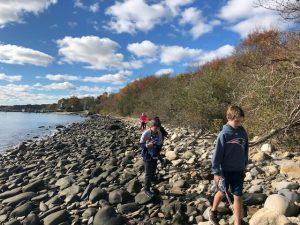
As the Capstone Experience for our third year students, we began the Narragansett Bay study with an introduction to its physical characteristics and inhabitants. Students spent the first several months of the study learning about salinity and density, collecting fish and invertebrates for the classroom tank with a minnow trap, studying plankton, and learning the food web in the Narragansett Bay, and along its shore. The children also familiarized themselves with a nautical chart of the bay and charted imaginary boats while measuring nautical miles and paying close attention to depths.
For the second half of the year we move the study onto land, and go back in history to examine the lives of the indigenous people of Narragansett and Rhode Island. To begin, the 3rd year students took a closer look at the composition of the sand on our beaches. We compared the sand from a local beach with collections of sand from many beaches around the world. The children also used magnets to collect the iron and were amazed at the large amount of iron in the sand.
At the end of January, we began our study of the Narragansett Tribe. Through the lens of the fundamental needs of humans, we studied the habits of the native people in this area. We read books and had lively discussions about how life was so different for them. The idea alone that they couldn’t go to the store was hard to actually conceptualize. They each built a replica of a wetu, or wigwam, in the classroom.
The students were also tasked with building a shelter in the woods here at school. This is always one of their favorite activities and it takes a surprisingly long time. They agreed that they were grateful they were not relying on their own shelters for protection this winter.
As we continue to look at the fauna of this area, we will be embarking on a seal watch out of Wickford this week and next week we will be dissecting owl pellets and looking at the birds of prey in this area. If anyone has a chance over break to get over to Sachuest Point in Middletown, you might be lucky enough to see a snowy owl. However, it is a beautiful walk even if you don’t spot the owl.
After our return from break we will be visiting the Mashantucket Pequot Museum in Connecticut. Hands down, this is one of the best ways for the children to get a sense of the Native American landscape. They have life-size exhibits and many artifacts and replicas for the children to see. It is an awe- inspiring museum.
